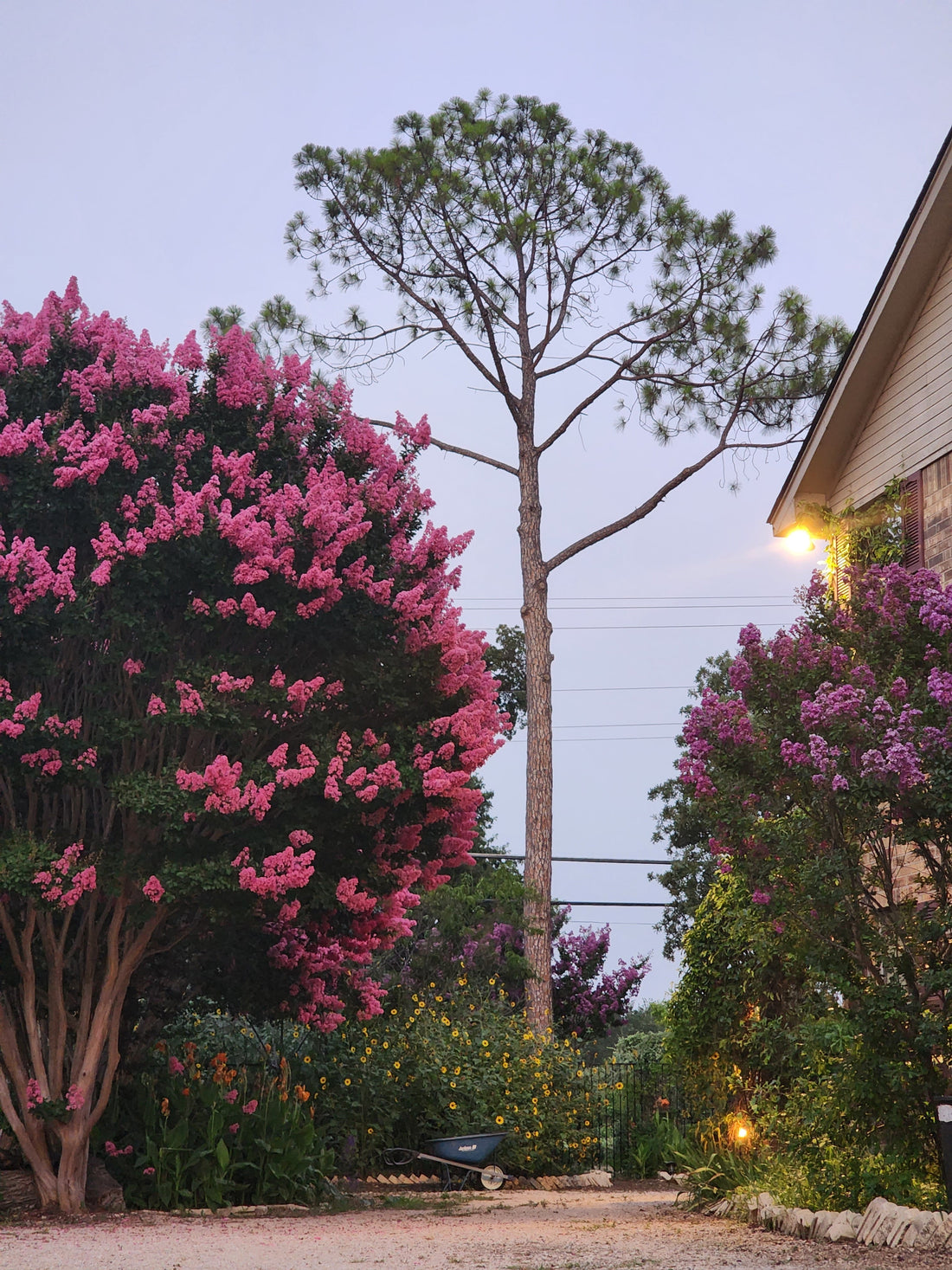15 Flowering Trees Every Texan Should Grow (Medicinal + Practical Edition)
Bismillah. A tree for every purpose under the sun.
1. Crape Myrtle (Lagerstroemia indica)
-
Medicinal Use: Bark traditionally used in Asian medicine for digestive issues.
-
Pollinator Value: High—bees, butterflies, and hummingbirds love it.
-
Practical Use: Excellent privacy screen or driveway accent.
-
Texas Tip: Thrives in full sun and tolerates drought. Prune in late winter to shape, not "crape murder."
2. Redbud (Cercis canadensis)
-
Medicinal Use: Edible flowers used for anti-inflammatory teas.
-
Pollinator Value: Early spring bloomer—critical nectar source for native bees.
-
Practical Use: Flowers and young pods are edible; good for permaculture.
-
Texas Tip: Native and adaptable. Forest Pansy variety is especially striking.
3. Vitex / Chaste Tree (Vitex agnus-castus)
-
Medicinal Use: Used for hormonal balancing, PMS, and menopausal symptoms.
-
Pollinator Value: Very high—draws bees and butterflies through late summer.
-
Practical Use: Air-freshening cut branches and herbal tinctures.
-
Texas Tip: Loves sun. Cut back aggressively in winter for fuller summer growth.
4. Southern Magnolia (Magnolia grandiflora)
-
Medicinal Use: Bark extract shows calming and anti-anxiety effects.
-
Pollinator Value: Large flowers attract beetles and pollinators.
-
Practical Use: Evergreen beauty; leaves used in garlands.
-
Texas Tip: Needs space. Protect from intense drought during youth.
5. Japanese Snowbell (Styrax japonicus)
-
Medicinal Use: Styrax resin used historically as incense and antimicrobial wash.
-
Pollinator Value: Bell-shaped flowers feed native bees.
-
Practical Use: Elegant shade tree; mild fragrance.
-
Texas Tip: Prefers morning sun and rich soil. Use as a patio or courtyard tree.
6. Hibiscus (H. rosa-sinensis or H. syriacus)
-
Medicinal Use: Calms blood pressure, supports heart health.
-
Pollinator Value: High—especially for butterflies and hummingbirds.
-
Practical Use: Makes tangy hibiscus tea (dried flowers).
-
Texas Tip: Hardy types (like Rose of Sharon) handle winters better. Water regularly in heat.
7. Kousa Dogwood (Cornus kousa)
-
Medicinal Use: Bark used for fevers; berries have antioxidant benefits.
-
Pollinator Value: Mid-spring blooms for bees and beneficial insects.
-
Practical Use: Late summer fruits are edible (jelly, wine).
-
Texas Tip: Requires morning sun and acidic soil. Better for East TX.
8. Saucer Magnolia (Magnolia × soulangeana)
-
Medicinal Use: Bark in Chinese medicine used for sinus support.
-
Pollinator Value: Attracts early-season bees.
-
Practical Use: Decorative flower petals for arrangements.
-
Texas Tip: Best in East or Central Texas. Needs rich, moist soil.
9. Serviceberry (Amelanchier arborea)
-
Medicinal Use: High antioxidant fruit; used for digestion and immunity.
-
Pollinator Value: Spring nectar + habitat for birds.
-
Practical Use: Edible berries rival blueberries. Great for jams.
-
Texas Tip: Choose drought-tolerant varieties like Autumn Brilliance.
10. Crabapple (Malus spp.)
-
Medicinal Use: Fruit is used in detox and pectin-rich remedies.
-
Pollinator Value: Excellent pollinator support tree.
-
Practical Use: Jelly, vinegar, and ornamental fall fruit.
-
Texas Tip: Requires chill hours. Best for North and Central TX.
11. Flowering Cherry (Prunus serrulata)
-
Medicinal Use: Bark extract used in cough remedies.
-
Pollinator Value: Bees love the dense floral displays.
-
Practical Use: Spring beauty, craft-worthy bark and branches.
-
Texas Tip: Select heat-tolerant varieties like Kwanzan. Needs consistent water.
12. Tea Olive (Osmanthus fragrans)
-
Medicinal Use: Flowers used in Chinese teas for digestion and breath.
-
Pollinator Value: Low, but provides scent and winter bloom.
-
Practical Use: Cuttings for fragrant wreaths.
-
Texas Tip: Needs partial shade. Great for borders or under larger trees.
13. Camellia (C. japonica or C. sinensis)
-
Medicinal Use: Green and black tea both come from Camellia sinensis.
-
Pollinator Value: Moderate. Early-season nectar source.
-
Practical Use: Source of ornamental tea and cosmetic oil.
-
Texas Tip: Needs acidic soil and some shade. Best in East Texas.
14. Heptacodium / Seven Sons Tree (Heptacodium miconioides)
-
Medicinal Use: Research ongoing; used in traditional Chinese medicine.
-
Pollinator Value: Superb late-season pollinator.
-
Practical Use: Stunning bark in winter, fragrant flowers in fall.
-
Texas Tip: Rare but grows well in rich, irrigated soil.
15. Japanese Snowball (Viburnum plicatum)
-
Medicinal Use: Viburnum species historically used for cramping and muscle pain.
-
Pollinator Value: Attracts bees, butterflies, and beneficial bugs.
-
Practical Use: Beautiful hedge; flowers useful for crafts.
-
Texas Tip: Provide rich, loamy soil. Needs some afternoon shade in hot zones.
Needing a great tree? Check out our Friends!
Needing help planting? Ping us or schedule a consultation.

